Projection of Thermal Bioclimate of Egypt for the Paris Agreement Goals
Abstract
1. Introduction
2. Research Area and Climate Data
2.1. Egypt
2.2. Climate Data
3. Methodology
4. Results
4.1. Annual Mean Temperature (Bio-1)
4.2. Diurnal Temperature Range (Bio-2)
4.3. Isothermality (Bio-3)
4.4. Temperature Seasonality (Bio-4)
4.5. Tmax in the Hottest Month (Bio-5)
4.6. Tmin in the Coldest Month (Bio-6)
4.7. Annual Range of Temperature (Bio-7)
4.8. Tmean of the Wettest Quarter (Bio-8)
4.9. Tmean of the Driest Quarter (Bio-9)
4.10. Tmean of the Warmest Quarter (Bio-10)
4.11. Tmean of the Coldest Quarter (Bio-11)
5. Discussion
6. Conclusions
Supplementary Materials
Author Contributions
Funding
Institutional Review Board Statement
Informed Consent Statement
Data Availability Statement
Conflicts of Interest
References
- Hamed, M.M.; Salem, M.; Shamsuddin, N.; Tarmizi, S. Thermal bioclimatic indicators over Southeast Asia: Present status and future projection using CMIP6. Environ. Sci. Pollut. Res. 2022, 1–20. [Google Scholar] [CrossRef] [PubMed]
- Hamed, M.M.; Nashwan, M.S.; Shahid, S. Projected changes in thermal bioclimatic indicators over the Middle East and North Africa under Paris climate agreement. Stoch. Environ. Res. Risk Assess. 2022, 1–18. [Google Scholar] [CrossRef]
- O’Donnell, M.S.; Ignizio, D.A. Bioclimatic Predictors for Supporting Ecological Applications in the Conterminous United States. U.S Geol. Surv. Data Ser. 691 2012, 10, 4–9. [Google Scholar]
- Salehie, O.; bin Ismail, T.; Hamed, M.M.; Shahid, S.; Idlan Muhammad, M.K. Projection of Hot and Cold Extremes in the Amu River Basin of Central Asia using GCMs CMIP6. Stoch. Environ. Res. Risk Assess. 2022, 1–22. [Google Scholar] [CrossRef]
- Çaliskan, O.; Türkoglu, N.; Matzarakis, A. The effects of elevation on thermal bioclimatic conditions in Uludağ (Turkey). Atmósfera 2013, 26, 45–57. [Google Scholar] [CrossRef][Green Version]
- Ragheb, A.A.; El-Darwish, I.I.; Ahmed, S. Microclimate and human comfort considerations in planning a historic urban quarter. Int. J. Sustain. Built Environ. 2016, 5, 156–167. [Google Scholar] [CrossRef]
- Duanmu, L.; Sun, X.; Jin, Q.; Zhai, Z. Relationship between Human Thermal Comfort and Indoor Thermal Environment Parameters in Various Climatic Regions of China. Procedia Eng. 2017, 205, 2871–2878. [Google Scholar] [CrossRef]
- Chemura, A.; Kutywayo, D.; Chidoko, P.; Mahoya, C. Bioclimatic modelling of current and projected climatic suitability of coffee (Coffea arabica) production in Zimbabwe. Reg. Environ. Chang. 2016, 16, 473–485. [Google Scholar] [CrossRef]
- Salman, S.A.; Hamed, M.M.; Shahid, S.; Ahmed, K.; Sharafati, A.; Asaduzzaman, M.; Ziarh, G.F.; Ismail, T.; Chung, E.-S.; Wang, X.-J.; et al. Projecting spatiotemporal changes of precipitation and temperature in Iraq for different shared socioeconomic pathways with selected Coupled Model Intercomparison Project Phase 6. Int. J. Climatol. 2022, 1–19. [Google Scholar] [CrossRef]
- Hamed, M.M.; Nashwan, M.S.; Shahid, S. A novel selection method of CMIP6 GCMs for robust climate projection. Int. J. Climatol. 2022, 42, 4258–4272. [Google Scholar] [CrossRef]
- Pour, S.H.; Wahab, A.K.A.; Shahid, S.; Wang, X. Spatial pattern of the unidirectional trends in thermal bioclimatic indicators in Iran. Sustainability 2019, 11, 2287. [Google Scholar] [CrossRef]
- Salehie, O.; Hamed, M.M.; bin Ismail, T.; Shahid, S. Projection of droughts in Amu river basin for shared socioeconomic pathways CMIP6. Theor. Appl. Climatol. 2022, 1–19. [Google Scholar] [CrossRef]
- Jones, M.C.; Dye, S.R.; Fernandes, J.A.; Frölicher, T.L.; Pinnegar, J.K.; Warren, R.; Cheung, W.W.L. Predicting the Impact of Climate Change on Threatened Species in UK Waters. PLoS ONE 2013, 8, e54216. [Google Scholar] [CrossRef] [PubMed]
- Sintayehu, D.W. Impact of climate change on biodiversity and associated key ecosystem services in Africa: A systematic review. Ecosyst. Heal. Sustain. 2018, 4, 225–239. [Google Scholar] [CrossRef]
- Hu, X.-G.; Jin, Y.; Wang, X.-R.; Mao, J.-F.; Li, Y. Predicting Impacts of Future Climate Change on the Distribution of the Widespread Conifer Platycladus orientalis. PLoS ONE 2015, 10, e0132326. [Google Scholar] [CrossRef]
- Waltari, E.; Schroeder, R.; McDonald, K.; Anderson, R.P.; Carnaval, A. Bioclimatic variables derived from remote sensing: Assessment and application for species distribution modelling. Methods Ecol. Evol. 2014, 5, 1033–1042. [Google Scholar] [CrossRef]
- Molloy, S.W.; Davis, R.A.; Van Etten, E.J.B. Species distribution modelling using bioclimatic variables to determine the impacts of a changing climate on the western ringtail possum (Pseudocheirus occidentals; Pseudocheiridae). Environ. Conserv. 2014, 41, 176–186. [Google Scholar] [CrossRef]
- Hamed, M.M.; Nashwan, M.S.; Shahid, S.; bin Ismail, T.; Wang, X.J.; Dewan, A.; Asaduzzaman, M. Inconsistency in historical simulations and future projections of temperature and rainfall: A comparison of CMIP5 and CMIP6 models over Southeast Asia. Atmos. Res. 2022, 265, 105927. [Google Scholar] [CrossRef]
- Salehie, O.; Ismail, T.B.; Shahid, S.; Hamed, M.M.; Chinnasamy, P.; Wang, X. Assessment of Water Resources Availability in Amu Darya River Basin Using GRACE Data. Water 2022, 14, 533. [Google Scholar] [CrossRef]
- Rehfeldt, G.E.; Worrall, J.J.; Marchetti, S.B.; Crookston, N.L. Adapting forest management to climate change using bioclimate models with topographic drivers. For. Int. J. For. Res. 2015, 88, 528–539. [Google Scholar] [CrossRef]
- Ribeiro, M.M.; Roque, N.; Ribeiro, S.; Gavinhos, C.; Castanheira, I.; Quinta-Nova, L.; Albuquerque, T.; Gerassis, S. Bioclimatic modeling in the Last Glacial Maximum, Mid-Holocene and facing future climatic changes in the strawberry tree (Arbutus unedo L.). PLoS ONE 2019, 14, e0210062. [Google Scholar] [CrossRef] [PubMed]
- Daham, A.; Han, D.; Matt Jolly, W.; Rico-Ramirez, M.; Marsh, A. Predicting vegetation phenology in response to climate change using bioclimatic indices in Iraq. J. Water Clim. Chang. 2018, 10, 835–851. [Google Scholar] [CrossRef]
- Pour, S.H.; Wahab, A.K.A.; Shahid, S. Spatiotemporal changes in precipitation indicators related to bioclimate in Iran. Theor. Appl. Climatol. 2020, 141, 99–115. [Google Scholar] [CrossRef]
- Bonan, G. A Land Surface Model (LSM Version 1.0) for Ecological, Hydrological, and Atmospheric Studies: Technical Description and User’s Guide. Natl. Cent. Atmos. Res. Boulder Color. 1996, 150, 1–115. [Google Scholar]
- Donner, L.J.; Schubert, W.H.; Somerville, R. The Development of Atmospheric General Circulation Models: Complexity, Synthesis and Computation; Cambridge University Press: Cambridge, UK, 2011; ISBN 0521190061. [Google Scholar]
- McKenney, D.W.; Pedlar, J.H.; Rood, R.B.; Price, D. Revisiting projected shifts in the climate envelopes of North American trees using updated general circulation models. Glob. Chang. Biol. 2011, 17, 2720–2730. [Google Scholar] [CrossRef]
- Eyring, V.; Bony, S.; Meehl, G.A.; Senior, C.A.; Stevens, B.; Stouffer, R.J.; Taylor, K.E. Overview of the Coupled Model Intercomparison Project Phase 6 (CMIP6) experimental design and organization. Geosci. Model Dev. 2016, 9, 1937–1958. [Google Scholar] [CrossRef]
- Hamed, M.M.; Nashwan, M.S.; Shahid, S. Inter-comparison of Historical Simulation and Future Projection of Rainfall and Temperature by CMIP5 and CMIP6 GCMs Over Egypt. Int. J. Climatol. 2022, 42, 4316–4332. [Google Scholar] [CrossRef]
- Taylor, K.E.; Stouffer, R.J.; Meehl, G.A. An overview of CMIP5 and the experiment design. Bull. Am. Meteorol. Soc. 2012, 93, 485–498. [Google Scholar] [CrossRef]
- Nashwan, M.S.; Shahid, S. Future precipitation changes in Egypt under the 1.5 and 2.0 °C global warming goals using CMIP6 multimodel ensemble. Atmos. Res. 2022, 265, 105908. [Google Scholar] [CrossRef]
- Abdelaal, M.; Fois, M.; Fenu, G.; Bacchetta, G. Biogeographical characterisation of Egypt based on environmental features and endemic vascular plants distribution. Appl. Geogr. 2020, 119, 102208. [Google Scholar] [CrossRef]
- Younis, A.M.; Nafea, S.M. Impact of environmental conditions on the biodiversity of Mediterranean Sea lagoon, Burullus protected area, Egypt. World Appl. Sci. J. 2012, 19, 1423–1430. [Google Scholar]
- Abbas, E.M.; Ismail, M.; El-Ganainy, A.; Ali, F.S. First DNA Barcoding-based Inventory of Suez Gulf Fishes in Egypt and its Implication for Species Diversity. J. Ichthyol. 2021, 61, 386–395. [Google Scholar] [CrossRef]
- Farrag, M.M.S.; El-Naggar, H.A.; Abou-Mahmoud, M.M.A.; Alabssawy, A.N.; Ahmed, H.O.; Abo-Taleb, H.A.; Kostas, K. Marine biodiversity patterns off Alexandria area, southeastern Mediterranean Sea, Egypt. Environ. Monit. Assess. 2019, 191, 367. [Google Scholar] [CrossRef] [PubMed]
- El Hadidi, M.N.; Hosni, H.A. Biodiversity in the Flora of Egypt BT. In The Biodiversity of African Plants, Proceedings of the XIVth AETFAT Congress, Wageningen, The Netherlands, 22–27 August 1994; van der Maesen, L.J.G., van der Burgt, X.M., van Medenbach de Rooy, J.M., Eds.; Springer Netherlands: Dordrecht, The Netherlands, 1996; pp. 785–787. ISBN 978-94-009-0285-5. [Google Scholar]
- Ayyad, M.A.; Fakhry, A.M.; Moustafa, A.-R.A. Plant biodiversity in the Saint Catherine area of the Sinai peninsula, Egypt. Biodivers. Conserv. 2000, 9, 265–281. [Google Scholar] [CrossRef]
- El-Sheikh, W.; El-Kenway, A.; Soliman, M. Biodiversity and Population Dynamics of Natural Enemies in the Western Desert Agro-Ecosystem, Egypt. Egypt. Acad. J. Biol. Sci. A Entomol. 2020, 13, 1–14. [Google Scholar] [CrossRef]
- Al-Najjar, T.; Rasheed, M.; Ababneh, Z.; Ababneh, A.; Al-Omarey, H. Heavy metals pollution in sediment cores from the Gulf of Aqaba, Red Sea. Nat. Sci. 2011, 3, 775. [Google Scholar] [CrossRef][Green Version]
- El-Amier, Y.A.; El-Alfy, M.A.; Darwish, D.H.; Basiony, A.I.; Mohamedien, L.I.; El-Moselhy, K.M. Distribution and Ecological Risk Assessment of Heavy Metals in Core Sediments of Burullus Lake, Egypt. Egypt. J. Aquat. Biol. Fish. 2021, 25, 1041–1059. [Google Scholar] [CrossRef]
- Soliman, M.M.; El-Hawagry, M.S. Impact of Urbanisation and Human Activities on Diversity and Abundance of Ulidiid Flies (Diptera: Ulidiidae) in Wadi El-Natroun, Egypt. Afr. Entomol. 2020, 28, 415–424. [Google Scholar] [CrossRef]
- Mona, M.H.; El-Naggar, H.A.; El-Gayar, E.E.; Masood, M.F.; Mohamed, E.-S.N.E. Effect of human activities on biodiversity in Nabq Protected Area, South Sinai, Egypt. Egypt. J. Aquat. Res. 2019, 45, 33–43. [Google Scholar] [CrossRef]
- Nashwan, M.S.; Shahid, S.; Dewan, A.; Ismail, T.; Alias, N. Performance of five high resolution satellite-based precipitation products in arid region of Egypt: An evaluation. Atmos. Res. 2020, 236, 104809. [Google Scholar] [CrossRef]
- Hamed, M.M.; Nashwan, M.S.; Shahid, S. Performance Evaluation of Reanalysis Precipitation Products in Egypt using Fuzzy Entropy Time Series Similarity Analysis. Int. J. Climatol. 2021, 41, 5431–5446. [Google Scholar] [CrossRef]
- Survey, B.A.; Kingdom, U.; Kingdom, U.; Survey, B.A.; Kingdom, U.; Kingdom, U. An Assessment of Recent and Future Temperature Change over the Sichuan Basin, China, Using CMIP5 Climate Models. J. Clim. 2017, 30, 6701–6722. [Google Scholar] [CrossRef]
- Hamed, M.M.; Nashwan, M.S.; Shiru, M.S.; Shahid, S. Comparison between CMIP5 and CMIP6 Models over MENA Region Using Historical Simulations and Future Projections. Sustainability 2022, 14, 10375. [Google Scholar] [CrossRef]
- Muhammad, M.K.I.; Shahid, S.; Hamed, M.M.; Harun, S.; Ismail, T.; Wang, X. Development of a Temperature-Based Model Using Machine Learning Algorithms for the Projection of Evapotranspiration of Peninsular Malaysia. Water 2022, 14, 2858. [Google Scholar] [CrossRef]
- Shahid, S.; Bin Harun, S.; Katimon, A. Changes in diurnal temperature range in Bangladesh during the time period 1961–2008. Atmos. Res. 2012, 118, 260–270. [Google Scholar] [CrossRef]
- Karoly, D.J.; Karl, B.; Stott, P.A.; Arblaster, J.M.; Meehl, G.A.; Broccoli, A.J.; Dixon, K.W. Detection of a Human Influence on North American Climate. Science 2003, 302, 1200–1203. [Google Scholar] [CrossRef]
- Nix, H.A. A biogeographic analysis of Australian elapid snakes. Atlas Elapid Snakes Aust. 1986, 7, 4–15. [Google Scholar]
- Chen, Y.; Liu, A.; Cheng, X. Quantifying economic impacts of climate change under nine future emission scenarios within CMIP6. Sci. Total Environ. 2020, 703, 134950. [Google Scholar] [CrossRef]
- Lelieveld, J.; Proestos, Y.; Hadjinicolaou, P.; Tanarhte, M.; Tyrlis, E.; Zittis, G. Strongly increasing heat extremes in the Middle East and North Africa (MENA) in the 21st century. Clim. Chang. 2016, 137, 245–260. [Google Scholar] [CrossRef]
- Vizy, E.K.; Cook, K.H.; Crétat, J.; Neupane, N. Projections of a wetter Sahel in the twenty-first century from global and regional models. J. Clim. 2013, 26, 4664–4687. [Google Scholar] [CrossRef]
- Seneviratne, S.I.; Donat, M.G.; Pitman, A.J.; Knutti, R.; Wilby, R.L. Allowable CO2 emissions based on regional and impact-related climate targets. Nature 2016, 529, 477–483. [Google Scholar] [CrossRef] [PubMed]
- Zittis, G.; Hadjinicolaou, P.; Lelieveld, J. Role of soil moisture in the amplification of climate warming in the eastern Mediterranean and the Middle East. Clim. Res. 2014, 59, 27–37. [Google Scholar] [CrossRef]
- Noce, S.; Caporaso, L.; Santini, M. A new global dataset of bioclimatic indicators. Sci. Data 2020, 1–12. [Google Scholar] [CrossRef] [PubMed]
- Navarro-Racines, C.E.; Tarapues-Montenegro, J.E.; Thornton, P.; Jarvis, A.; Ramirez-Villegas, J. CCAFS-CMIP5 Delta Method Downscaling for Monthly Averages and Bioclimatic Indices of Four RCPs. World Data Center for Climate (WDCC) at DKRZ. 2019. Available online: https://www.wdc-climate.de/ui/entry?acronym=CCAFS-CMIP5_downscaling (accessed on 25 September 2022).
- Phillips, T.J.; Bonfils, C.J.W. Köppen bioclimatic evaluation of CMIP historical climate simulations. Environ. Res. Lett. 2015, 10, 064005. [Google Scholar] [CrossRef]
- Nashwan, M.S.; Shahid, S. A novel framework for selecting general circulation models based on the spatial patterns of climate. Int. J. Climatol. 2020, 40, 4422–4443. [Google Scholar] [CrossRef]
- Nashwan, M.S.; Shahid, S.; Chung, E.S. High-resolution climate projections for a densely populated mediterranean region. Sustainability 2020, 12, 3684. [Google Scholar] [CrossRef]
- IPCC Summary for Policymakers. Climate Change 2021: The Physical Science Basis. Contribution of Working Group I to the Sixth Assessment Report of the Intergovernmental Panel on Climate Change; Masson-Delmotte, V., Zhai, A.P., Pirani, S.L., Connors, C., Péan, S., Berger, N., Caud, Y., Chen, L., Goldfarb, M.I., Gomis, M., et al., Eds.; Cambridge University Press: Cambridge, UK, 2021. [Google Scholar]
- Lee, J.-Y.; Marotzke, J.; Bala, G.; Cao, L.; Corti, S.; Dunne, J.P.; Engelbrecht, F.; Fischer, E.; Fyfe, J.C.; Jones, C.; et al. Future Global Climate: Scenario-Based Projections and Near-Term Information. In Climate Change 2021: The Physical Science Basis. Contribution of Working Group I to the Sixth Assessment Report of the Intergovernmental Panel on Climate Change; Masson-Delmotte, V.P., Zhai, A., Pirani, S.L., Connors, C., Péan, S., Berger, N., Caud, Y.C., Eds.; Cambridge University Press: Cambridge, UK, 2021. [Google Scholar]
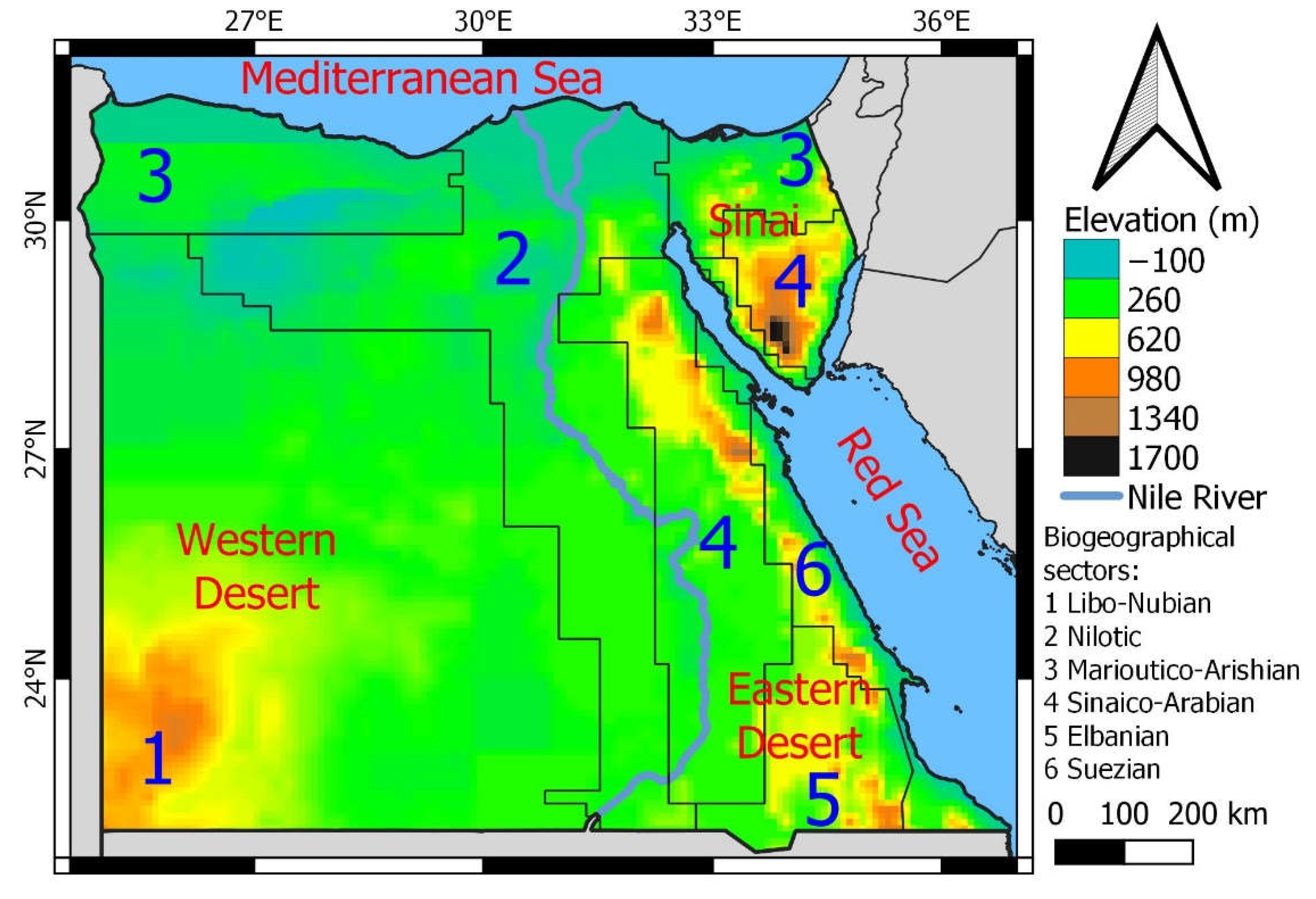
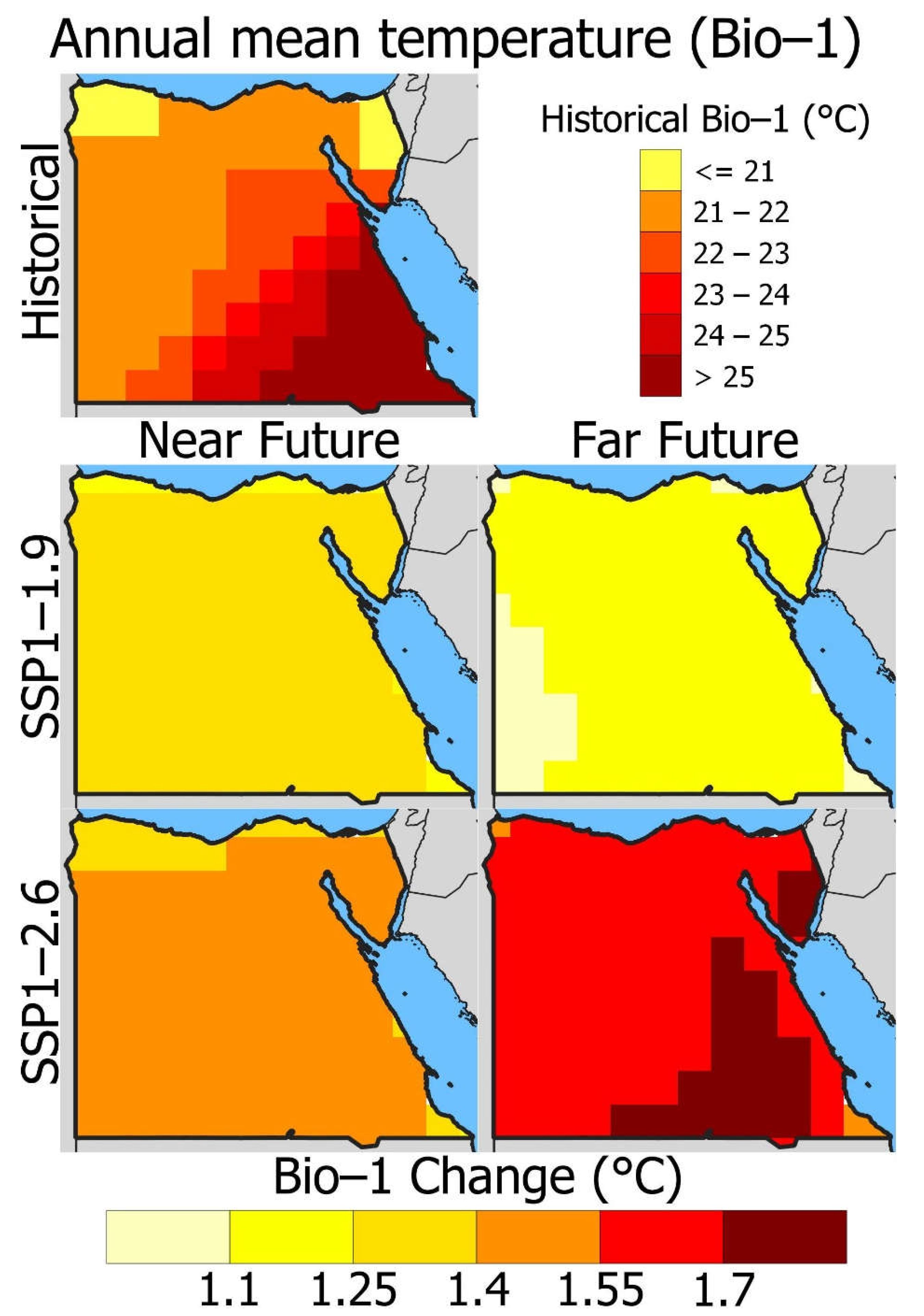
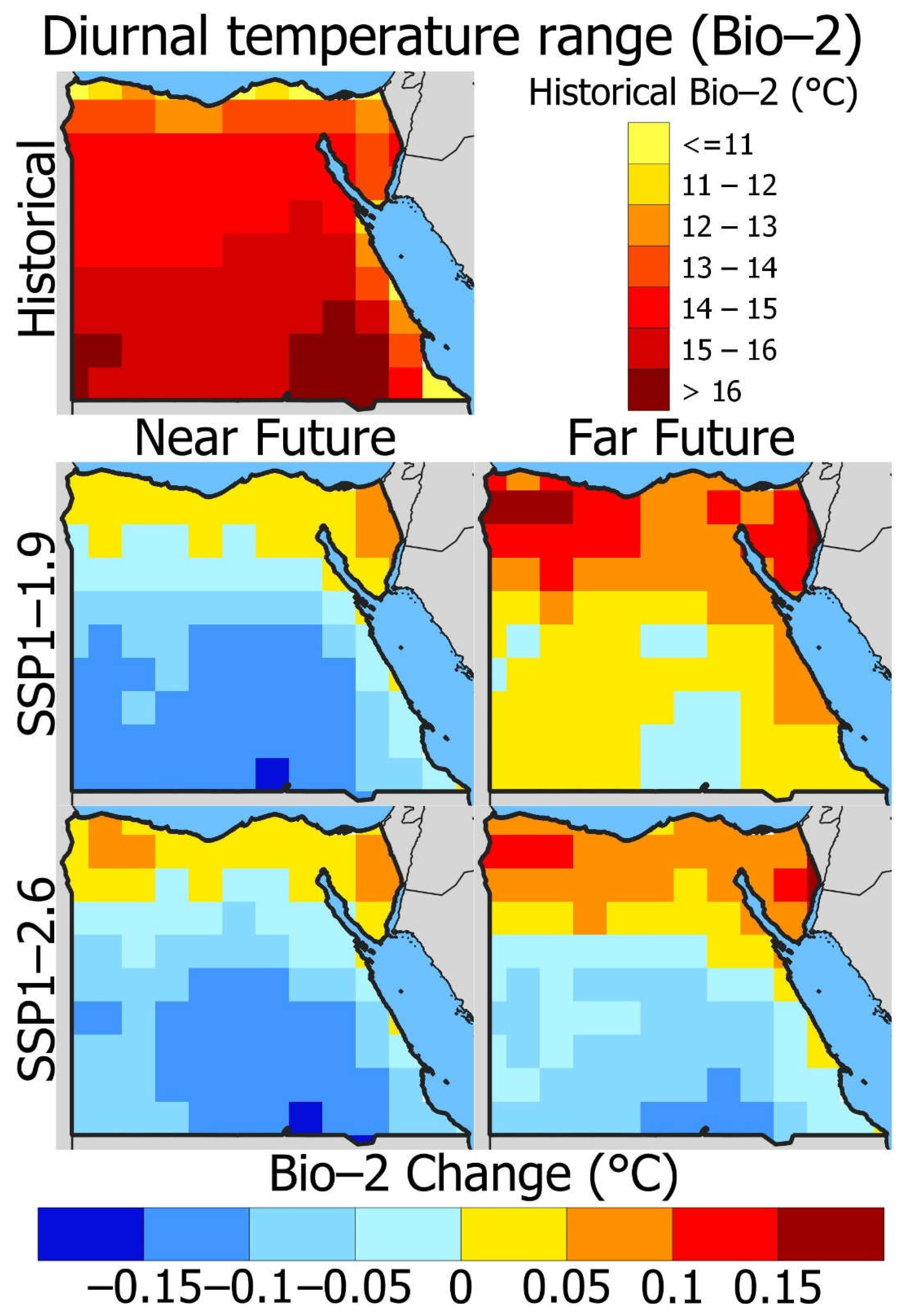
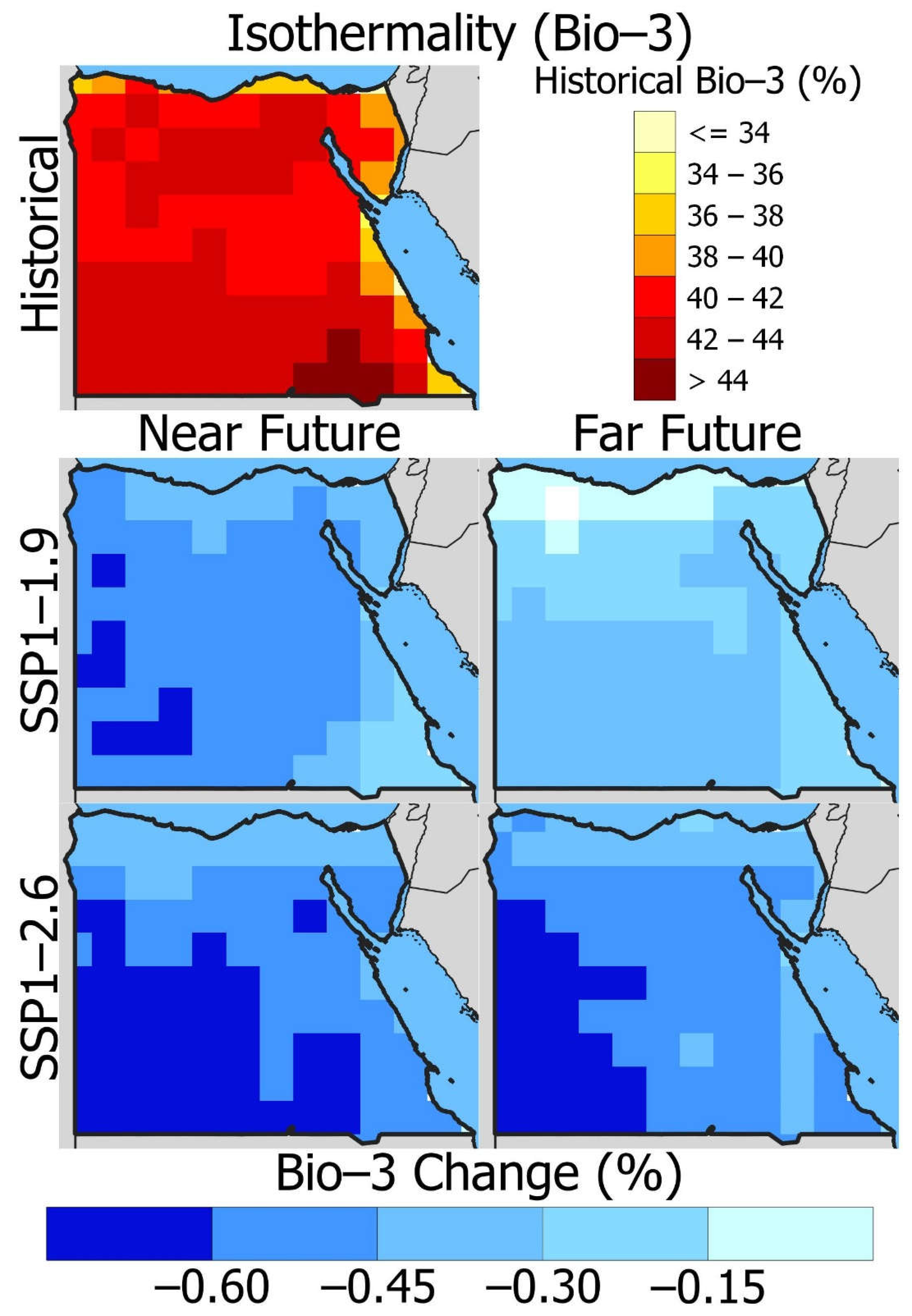
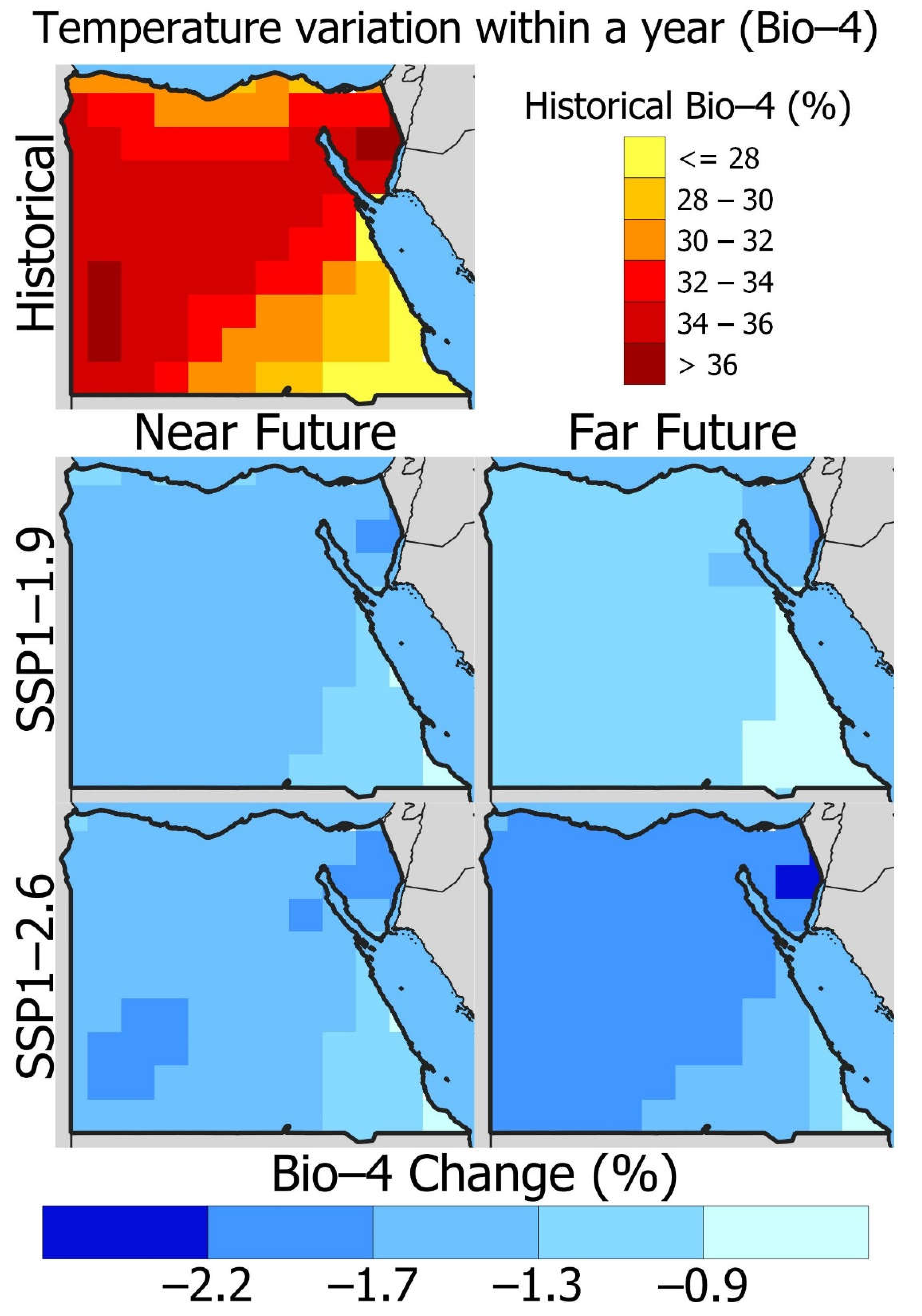
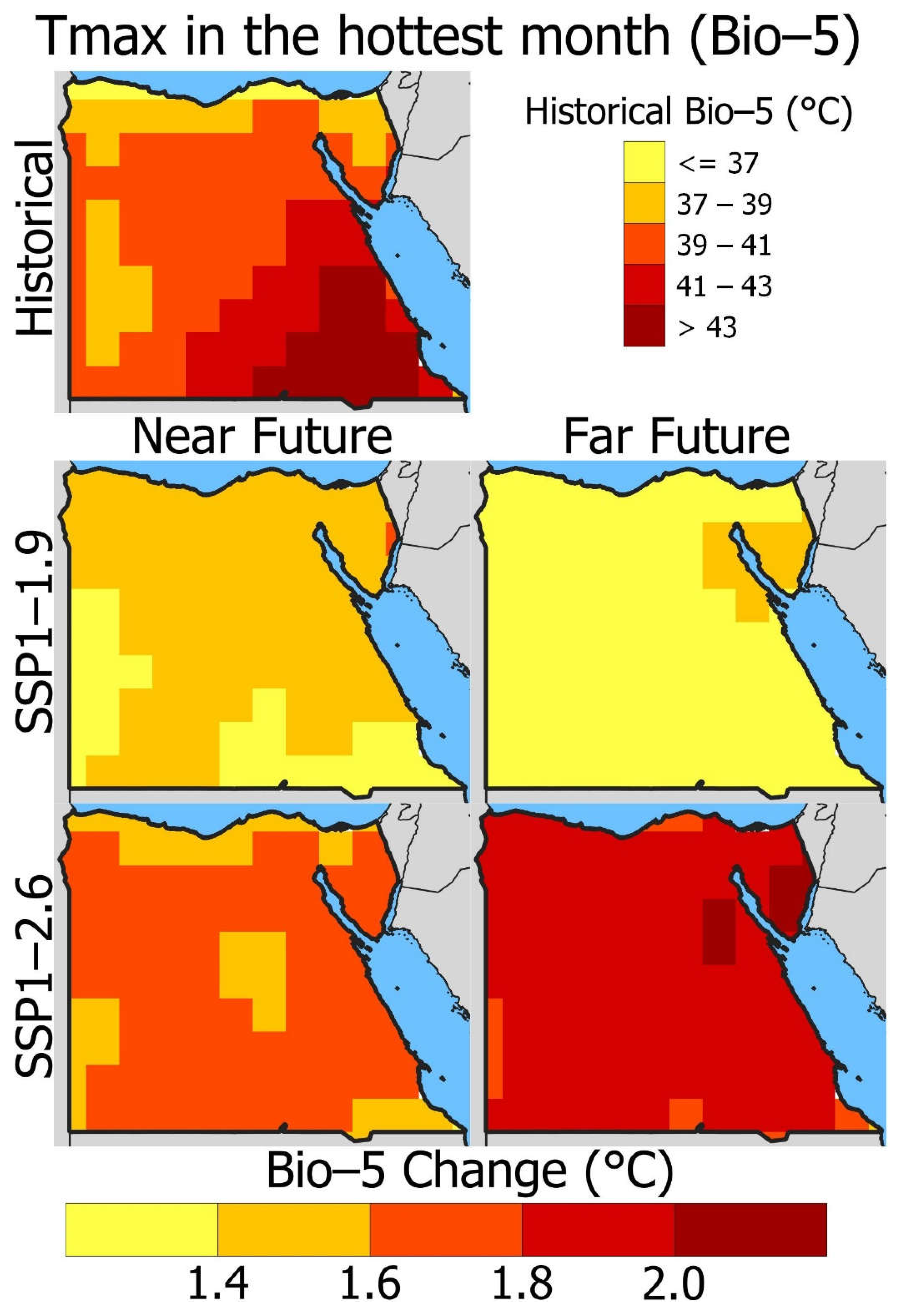

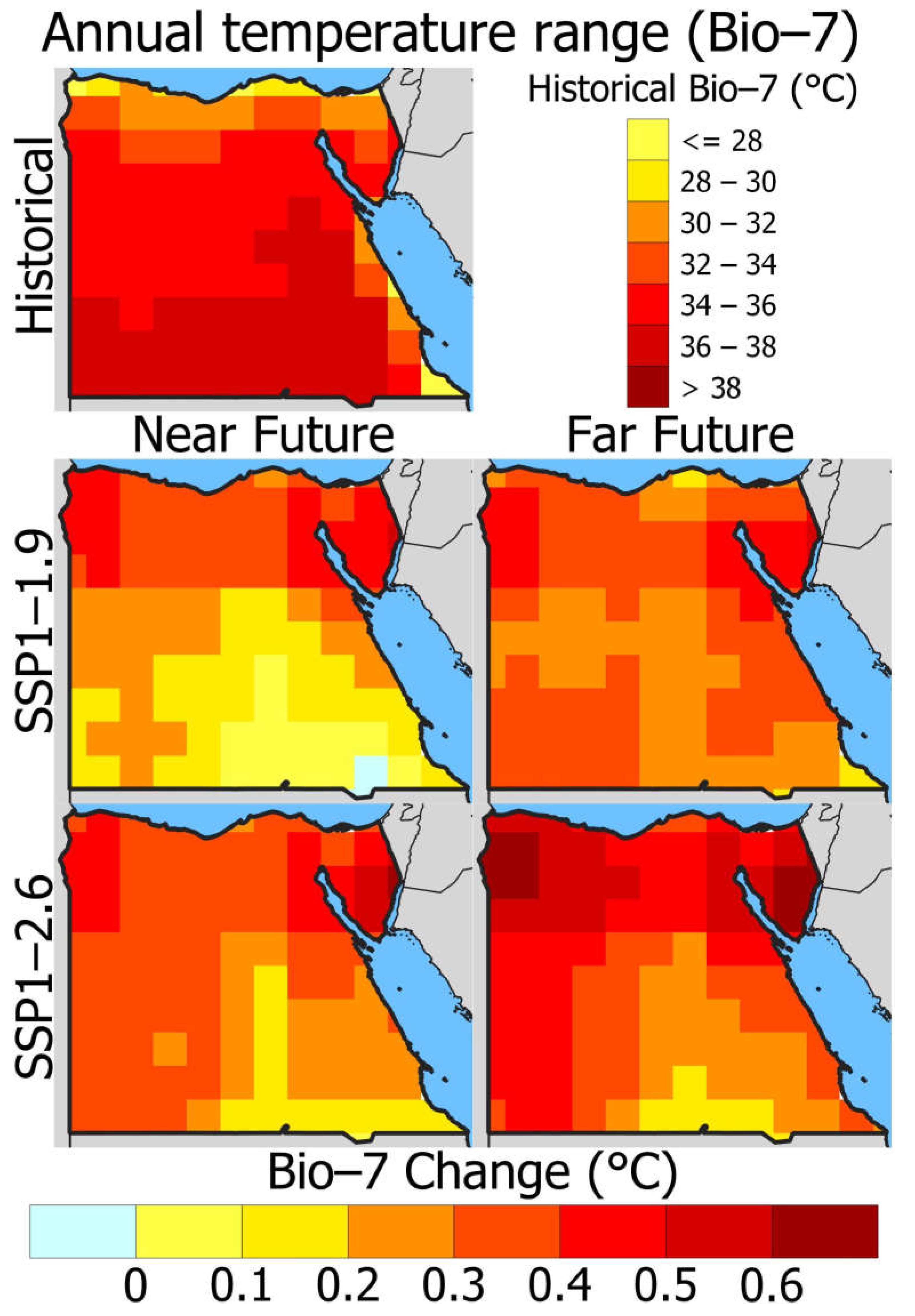
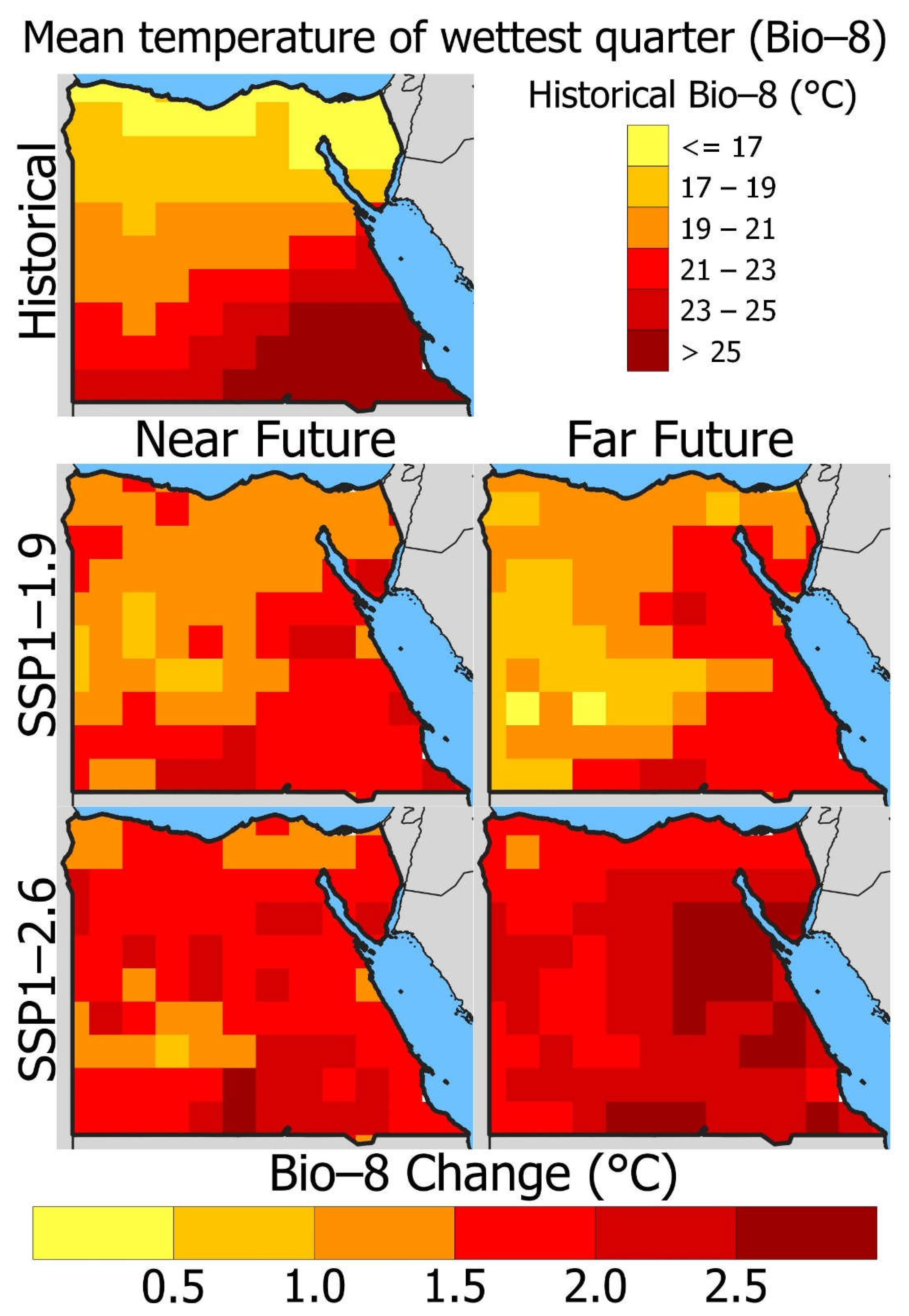
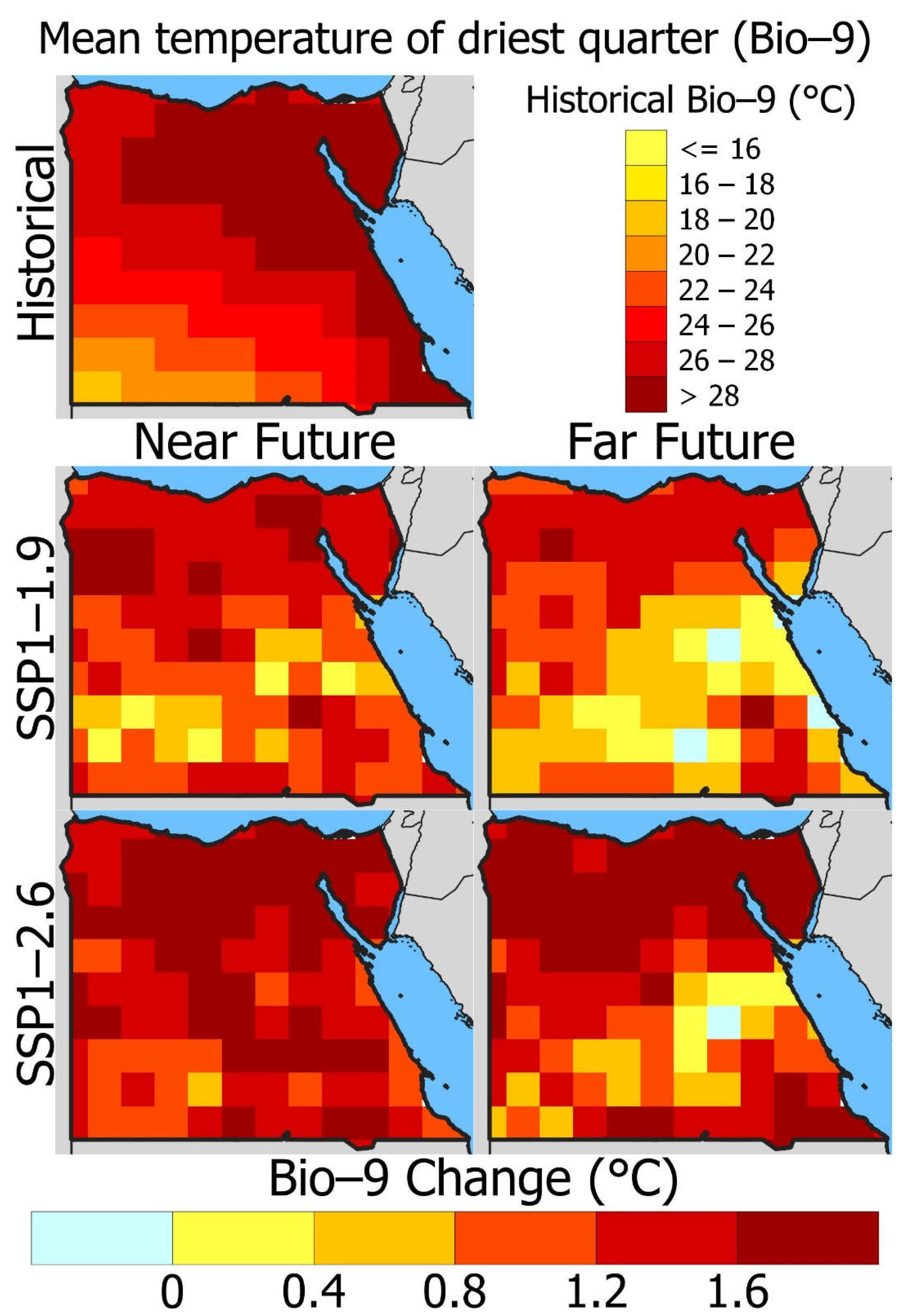

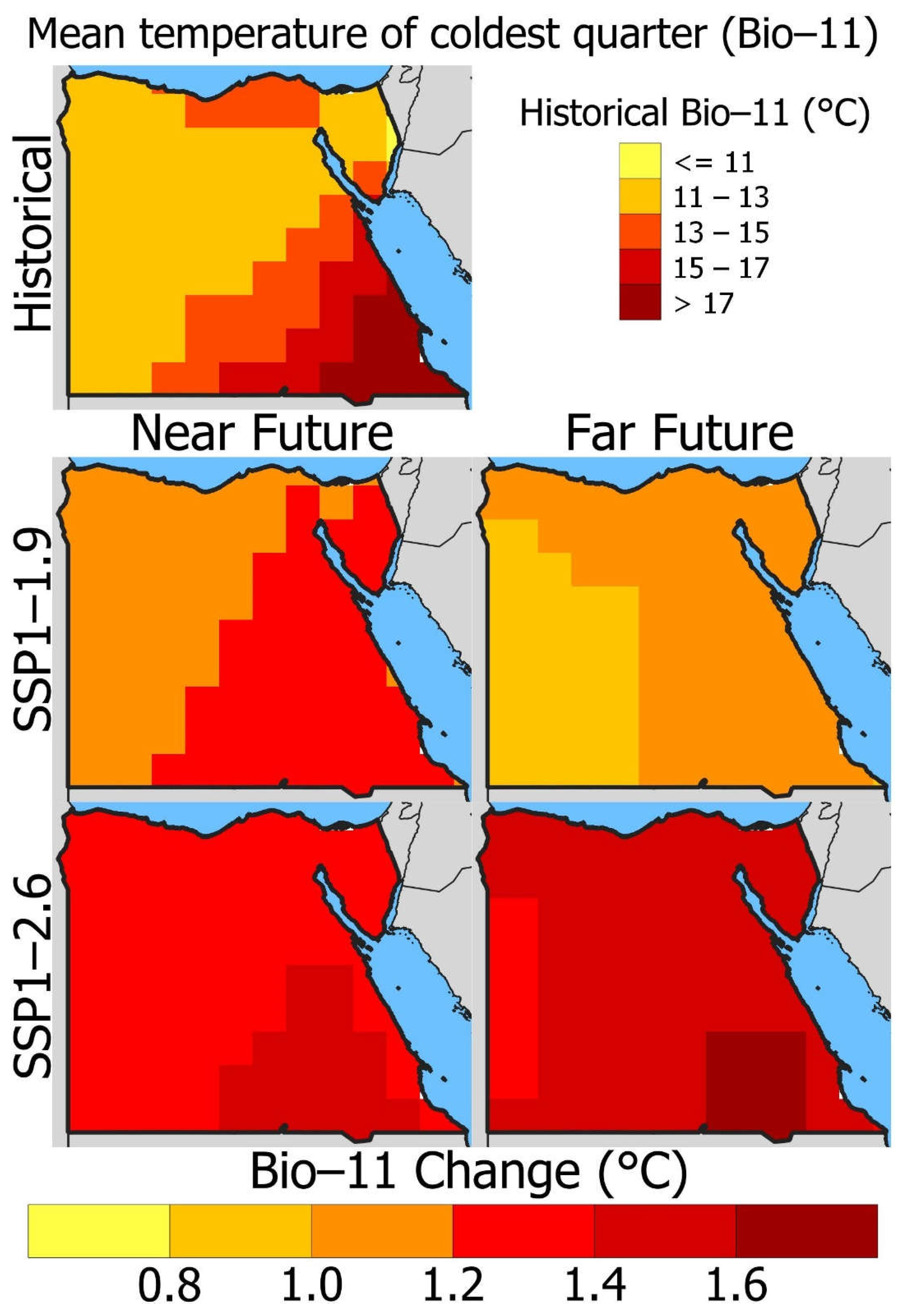
| Indicator | Change | |
|---|---|---|
| Increase | Decrease | |
| Bio-1 | Entire study area. A higher increase was projected for SSP1-2.6 in 2060–2099. | - |
| Bio-2 | North region. A higher increase was projected in the northeast. | South region. A higher decrease was projected in the southwest. |
| Bio-3 | - | All over the study area. The southwest has a greater projected decline. |
| Bio-4 | - | All over the study area, with a greater decline projected in the northeast |
| Bio-5 | All over the study area, with a greater increase projected in the northeast | - |
| Bio-6 | All over the study area. The south and southeast have a higher projected increase. | - |
| Bio-7 | All over the study area. The north has a higher projected increase. | - |
| Bio-8 | All over the study area. A higher increase was projected in the east (Red Sea). | - |
| Bio-9 | All over the study area. The north has a higher projected increase. | Red Sea region |
| Bio-10 | All over the study area | - |
| Bio-11 | All over the study area. The southeast has a higher projected increase. | - |
Publisher’s Note: MDPI stays neutral with regard to jurisdictional claims in published maps and institutional affiliations. |
© 2022 by the authors. Licensee MDPI, Basel, Switzerland. This article is an open access article distributed under the terms and conditions of the Creative Commons Attribution (CC BY) license (https://creativecommons.org/licenses/by/4.0/).
Share and Cite
Hamed, M.M.; Nashwan, M.S.; Ismail, T.b.; Shahid, S. Projection of Thermal Bioclimate of Egypt for the Paris Agreement Goals. Sustainability 2022, 14, 13259. https://doi.org/10.3390/su142013259
Hamed MM, Nashwan MS, Ismail Tb, Shahid S. Projection of Thermal Bioclimate of Egypt for the Paris Agreement Goals. Sustainability. 2022; 14(20):13259. https://doi.org/10.3390/su142013259
Chicago/Turabian StyleHamed, Mohammed Magdy, Mohamed Salem Nashwan, Tarmizi bin Ismail, and Shamsuddin Shahid. 2022. "Projection of Thermal Bioclimate of Egypt for the Paris Agreement Goals" Sustainability 14, no. 20: 13259. https://doi.org/10.3390/su142013259
APA StyleHamed, M. M., Nashwan, M. S., Ismail, T. b., & Shahid, S. (2022). Projection of Thermal Bioclimate of Egypt for the Paris Agreement Goals. Sustainability, 14(20), 13259. https://doi.org/10.3390/su142013259









